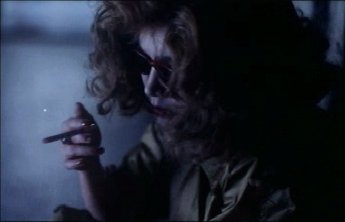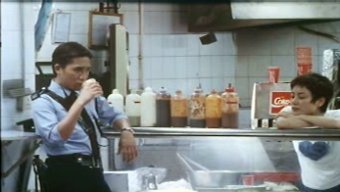|
Text and layout © Ed Shum, 2003. Ed Shum asserts the moral right to be identified as the author of this work |
|
Long Reviews |
|
Much has understandably been made of the look of Chungking Express. Cinematographer Chris Doyle rightfully gets praise for his clever mixing of controlled time and colour. The blurred stop-motion action sequences (actually an innovation of Andrew Lau, cinematographer with Wong Kar Wai back from As Tears Go By), though admittedly simple, have gone down in cinema history (and caused much imitation). Add to this mixed time lapsed shots and careful judging of light and colour and distance of shot between the stories, and the result is impressive, not just technically but in creating the perfect atmosphere. |
|
Now to the actual film. |
|
Review of Chungking Express (1994) |
|
|
|
...Continued... [Page 2] |
|
End |
|
The first story is criticized by some fans for lacking the energy or uplift of the second. This is true, and much of the substance is actually closer to other films by Wong Kar Wai. If watching the second part doesn’t overshadow some of the feelings associated with the first section, one can actually see the depth of desperation in Takeshi Kaneshiro’s character in the first story: he delays the emotional impact of being dumped for a month, and magnifies it to the point that he believes ‘all will end’ if his girlfriend doesn’t return. Add to this the seedy night of the Chungking Mansions area, and the feel is not exactly upbeat. Originally I was unimpressed at the portrayal of Indians in the ghetto until I realised that the area hadn’t been filmed before, meaning the occupants were culturally faceless as far as Hong Kong cinema was concerned. |
|
Wong Kar Wai’s spin is that the face of the drug running is in fact Brigitte Lin - a glamourous and famous star known to all - the opposite to being faceless. Her character is deliberately pretentious looking: but although she gives an explanation for her attire (shades and raincoat - because she never knows when it will rain or shine), like many of the other characters she may be using a code or conceit to sidestep an explicit statement of emotion. Though Kaneshiro meets her early on, he doesn’t interact with her until much later when he sets himself the task of loving the first woman to walk in the bar. Slyly then, Wong Kar Wai manages to put a spin on the question of just what love is. This builds up to the end of the first story when Kaneshiro hopes he’ll remember her forever, or as long as possible - his memory of her all that remains. Much of his dilemma is reminiscent of Leslie Cheung’s in Ashes Of Time: challenged with the loss of a relationship he attempts a different routine to enable him to forget. But while Cheung can’t forget, Kaneshiro gives himself the task of rebounding onto another woman - and she responds with the small gesture of remembrance which prevents his total emotional isolation. |
|
It is in the first half of the film that the notion, theme or conceit of expiry dates arises. Clearly this can be a reference to the impending end of Hong Kong as a British colony, but it is also a general theme which relates to the theme of change in the second half. It is no surprise that, together with the theme of change and dreams and travel (escape?) later on, people have perhaps over-emphasised the political reference as being absolute and central. Wong Kar Wai appears actually to be showing impermanence in everything (a concept prevalent in many philosophies), whereas some of his characters are unprepared for such change. In the ultra-transient setting of Hong Kong the effect is all the more profound, particularly when different time flows and deadlines converge and coincide. An example is when we hear Dennis Brown’s slow, soulful tones on the jukebox for the final time, and Brigitte Lin unexpectedly switches who is to be subject to an expiry date. Or there is also the scene where Kaneshiro and Brigitte Lin share a room for the night, and she simply falls asleep leaving him with about four hours to spare (it’s at least two hours since his birthday started, and he leaves before his birth time of 6 a.m.). All he does is eat chef salads and watch TV, yet there is a sublime thrill to the perfectly captured impermanence of this scene. Rather than invoking anticipation, the moment is held within its own confines, finite yet eternal, enhanced by Don’t Look Now-style time inter-cutting of two different shots (although, ironically, it is not a sex scene but Kaneshiro eating and brushing his teeth - incidentally, the inter-cutting is not apparent in the international release version of the film, which features many minor differences). Wong Kar Wai invites us to share this ethereal scene, yet he also asks us to acknowledge that for Brigitte Lin this has been a non-experience - she sleeps through it and is only aware of an act of kindness where Kaneshiro has removed and polished her shoes. |
|
Ashes of a minute: WKW plays with the concept of time, not just as a notion referred to directly by his characters, but as something underlying which is inseparable from narrative, emotion and the very idea or possibility of change. Specifically, the above scene mirrors Sergio Leone’s For A Few Dollars More - where in that film a musical pocket-watch provides a minute of tension (expanded to three minutes at the end of that film), in Chungking Brigitte Lin finds an unexpected minute of peace whilst being ceaselessly hunted down |
|
The second story appears different in terms of lighting and feel. Most shots are by day (Chris Doyle’s own apartment being a location). It’s got its own themes and its own conceits. Once again a cop (Tony Leung) finds it hard to accept a change of relationship. There is the conceit of flying and, yes, the emotional self-help to be found in house-hold goods. Eventually, it is Faye Wong who comes along to give Leung a taste of change - something which refreshes the audience well before Leung realises what has happened. |
|
A brief history of time: what WKW brings to the screen so succinctly, so successfully, is a sense of brilliant subjectivity - his characters can inhabit the same space and time, yet even these basic concepts are themselves merely relative and malleable to individual mood (something excellently depicted in the above scene), and the feel is of each character being in their own world - with any emotional connection seeming all the more precious. This isn’t a simple trumpeting of individualism though - we are made privy to a character’s consciousness via WKW’s technique, in a manner that is simply beyond many other filmmakers. WKW allows us to connect with this at a primary emotional level, and in an unabashedly vulnerable manner |
|
Page: |
|
Page: |

